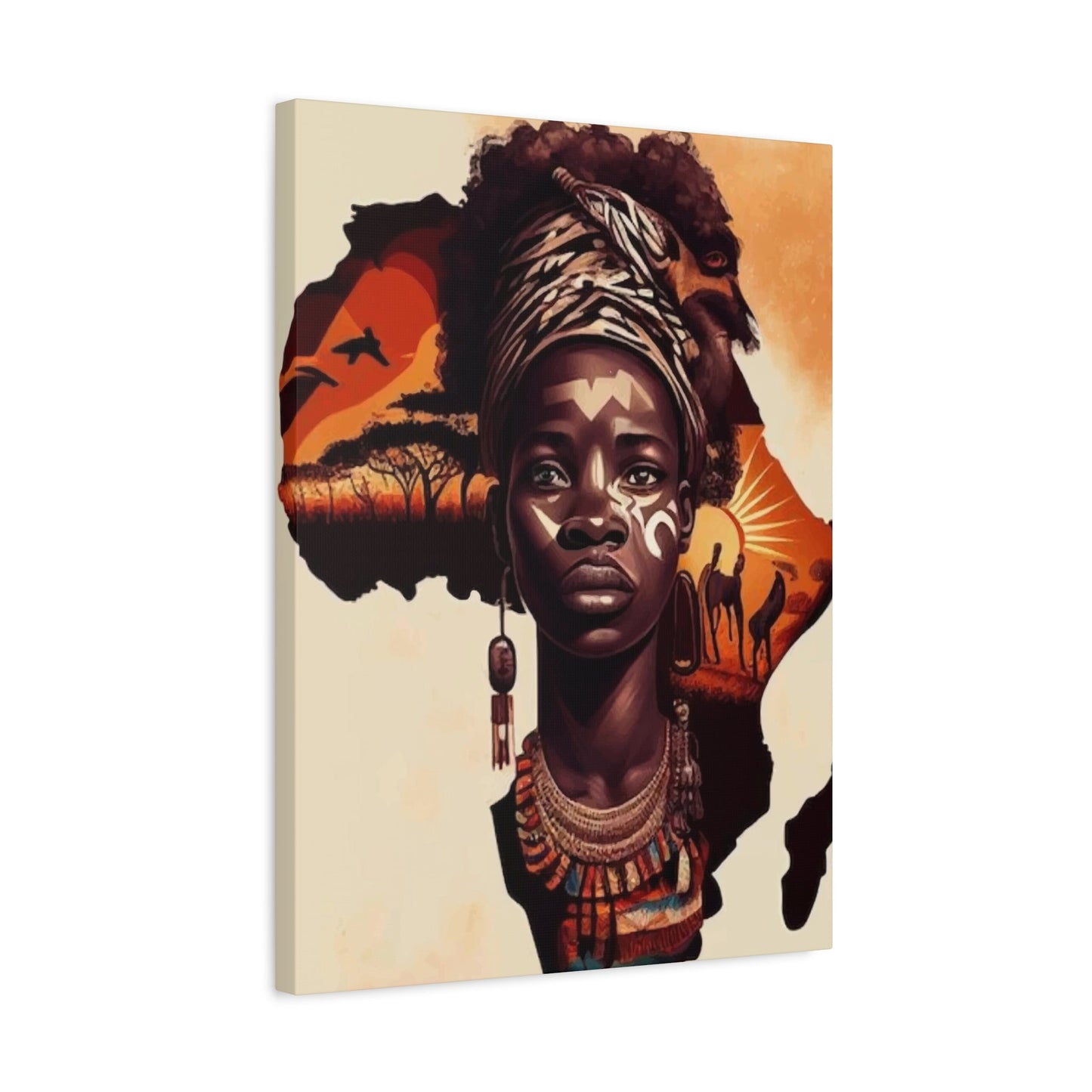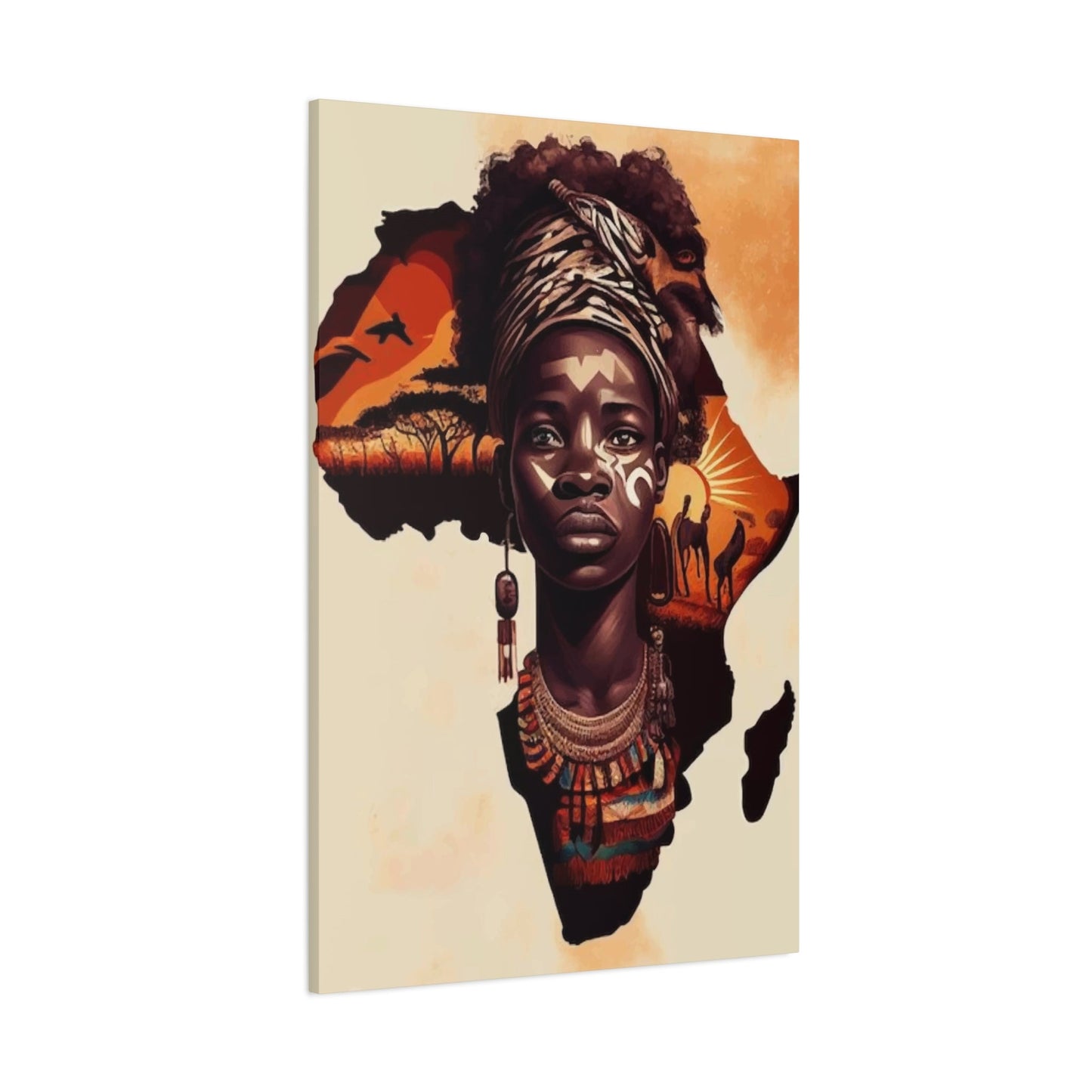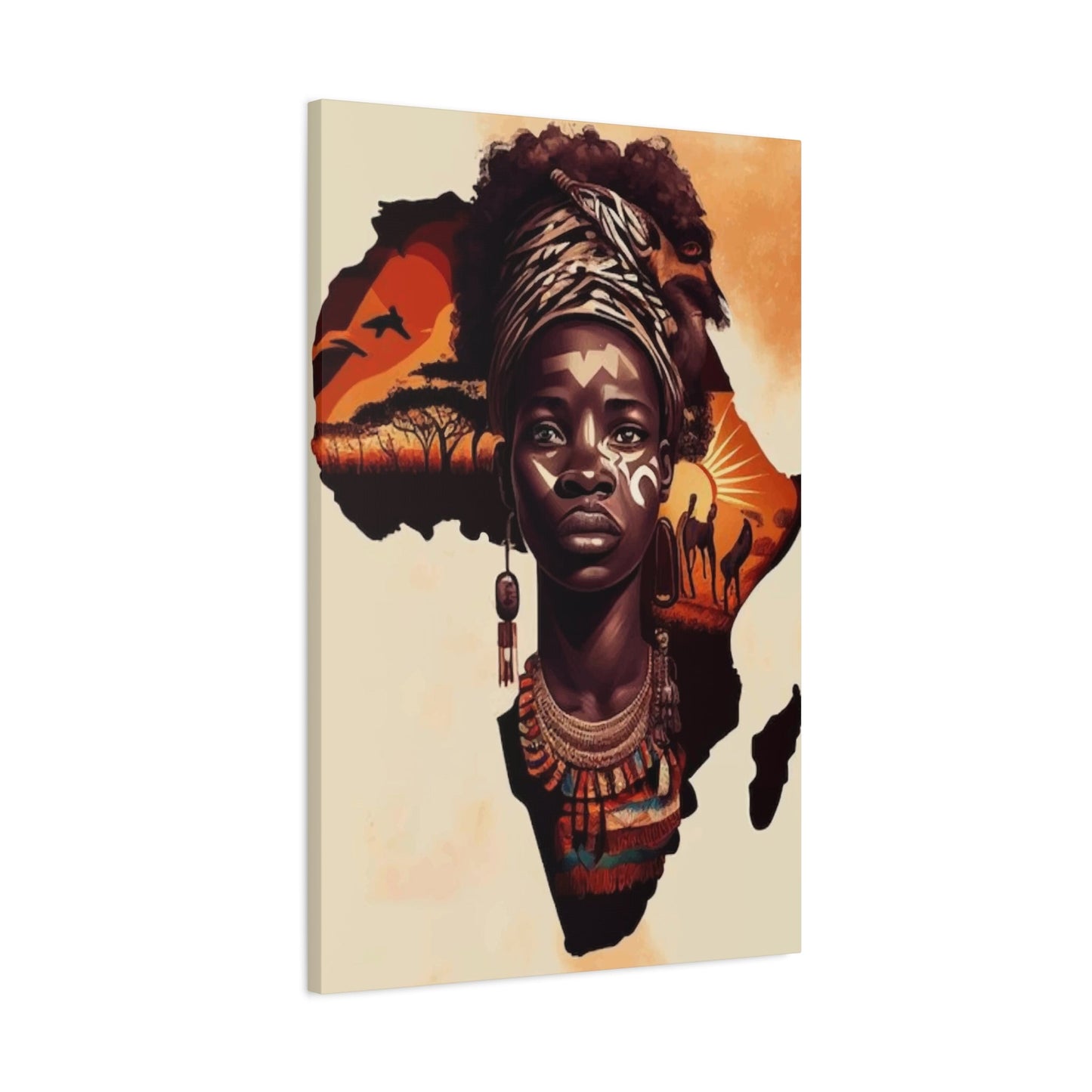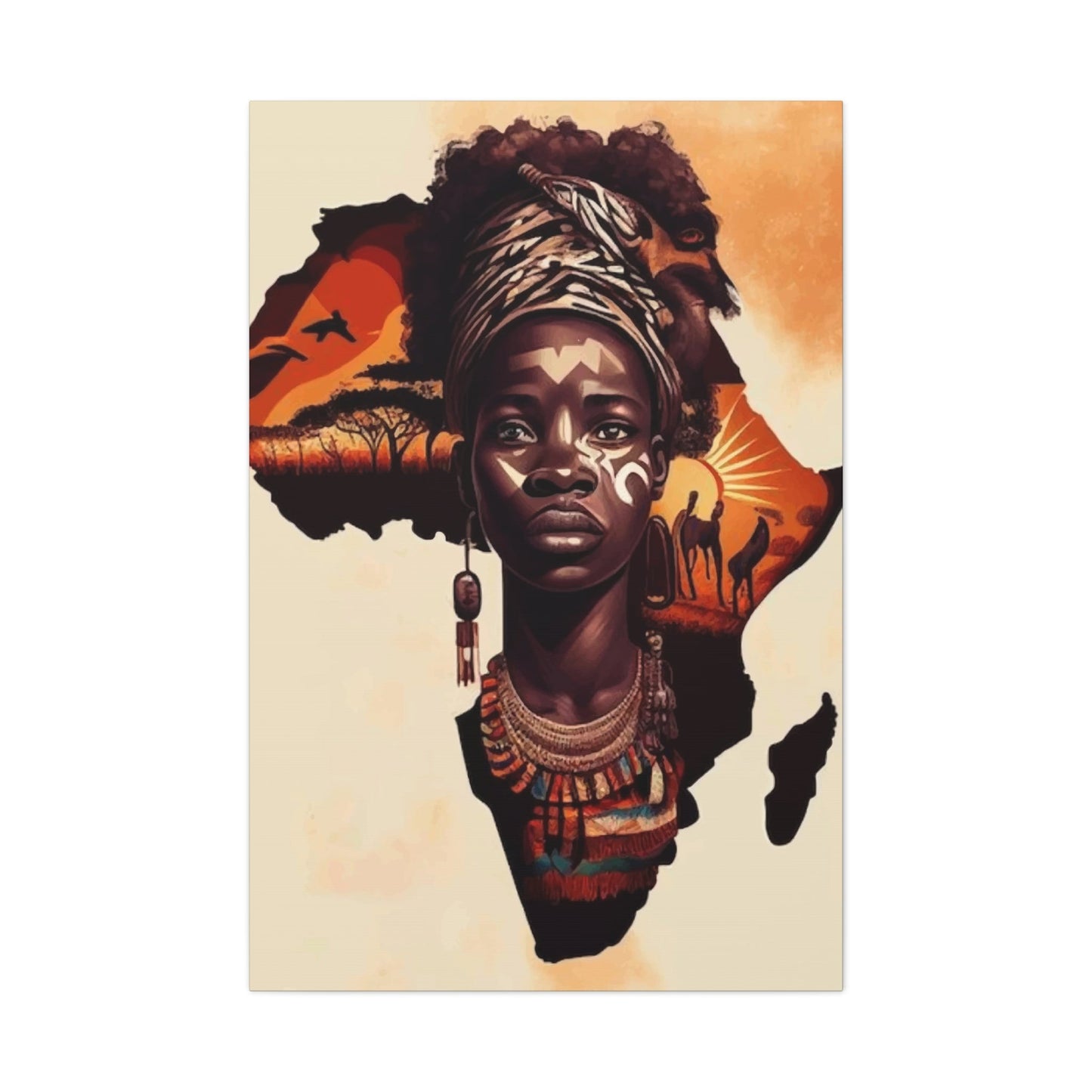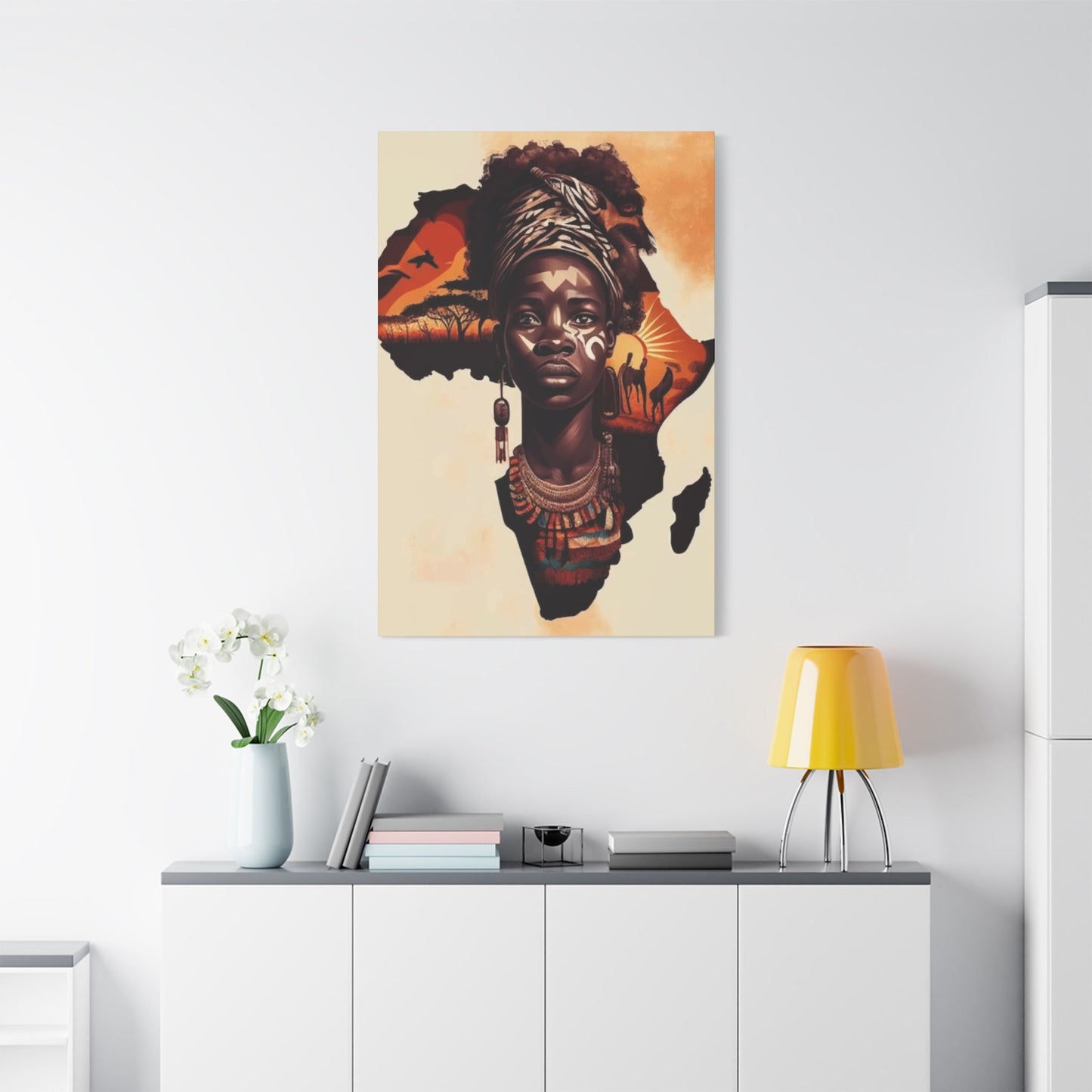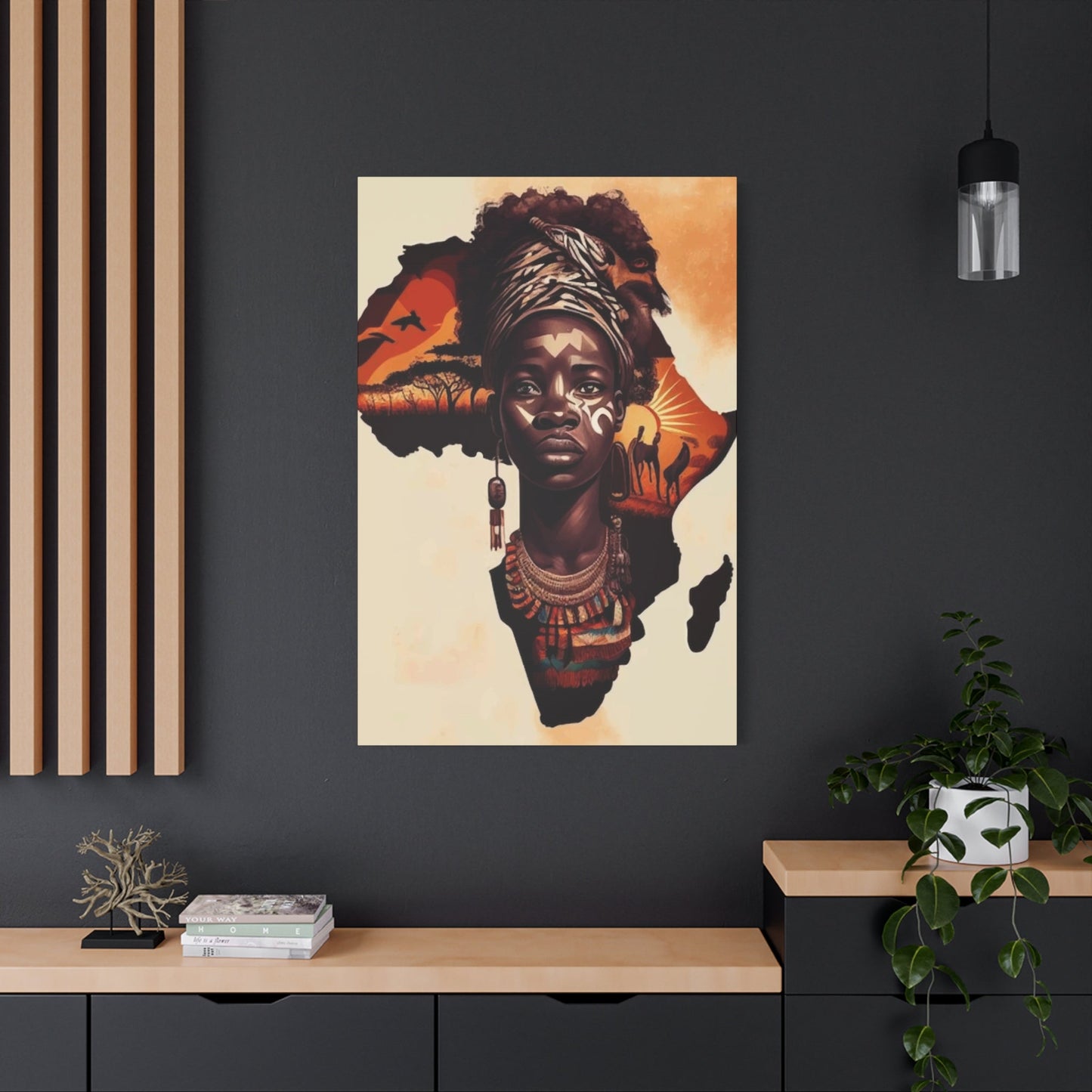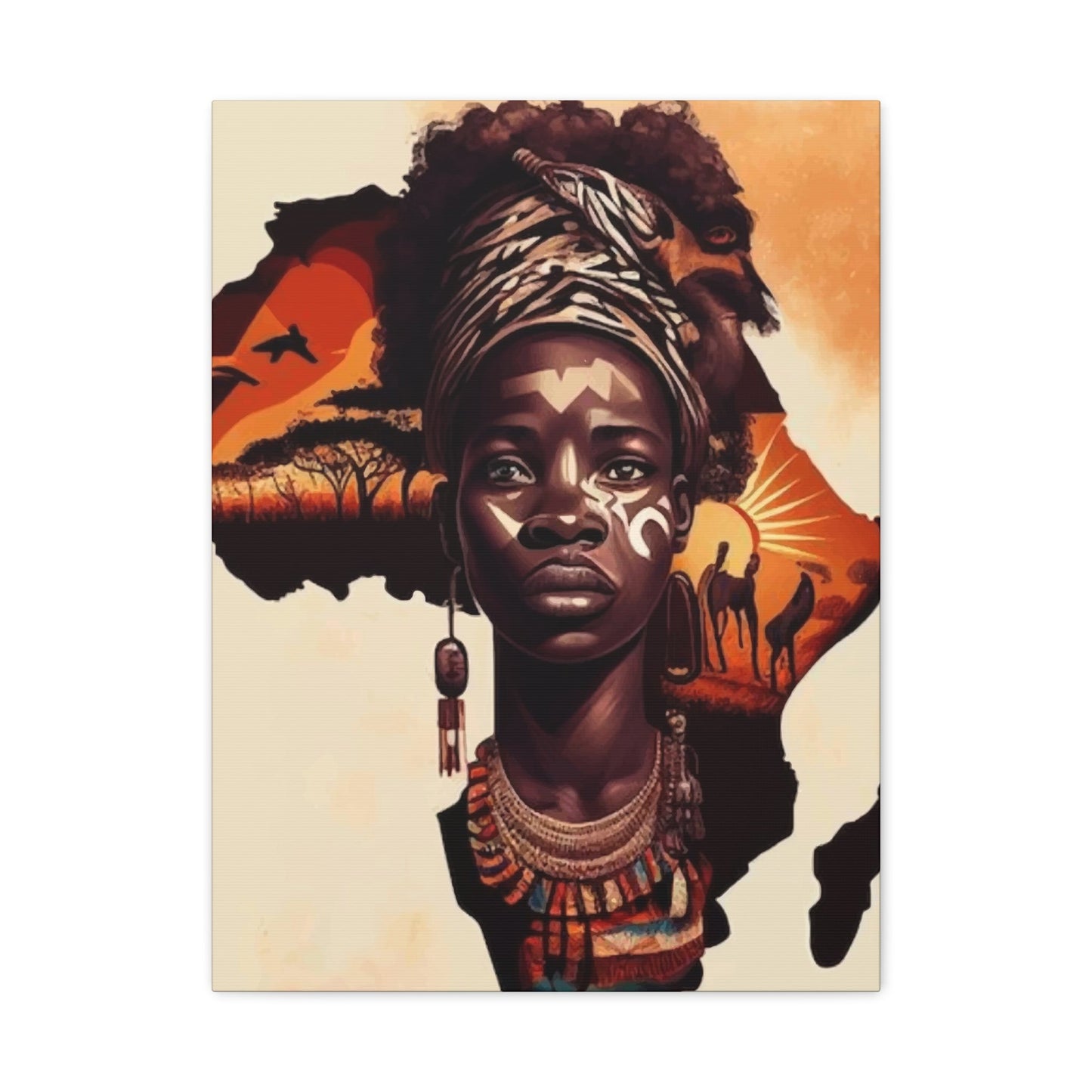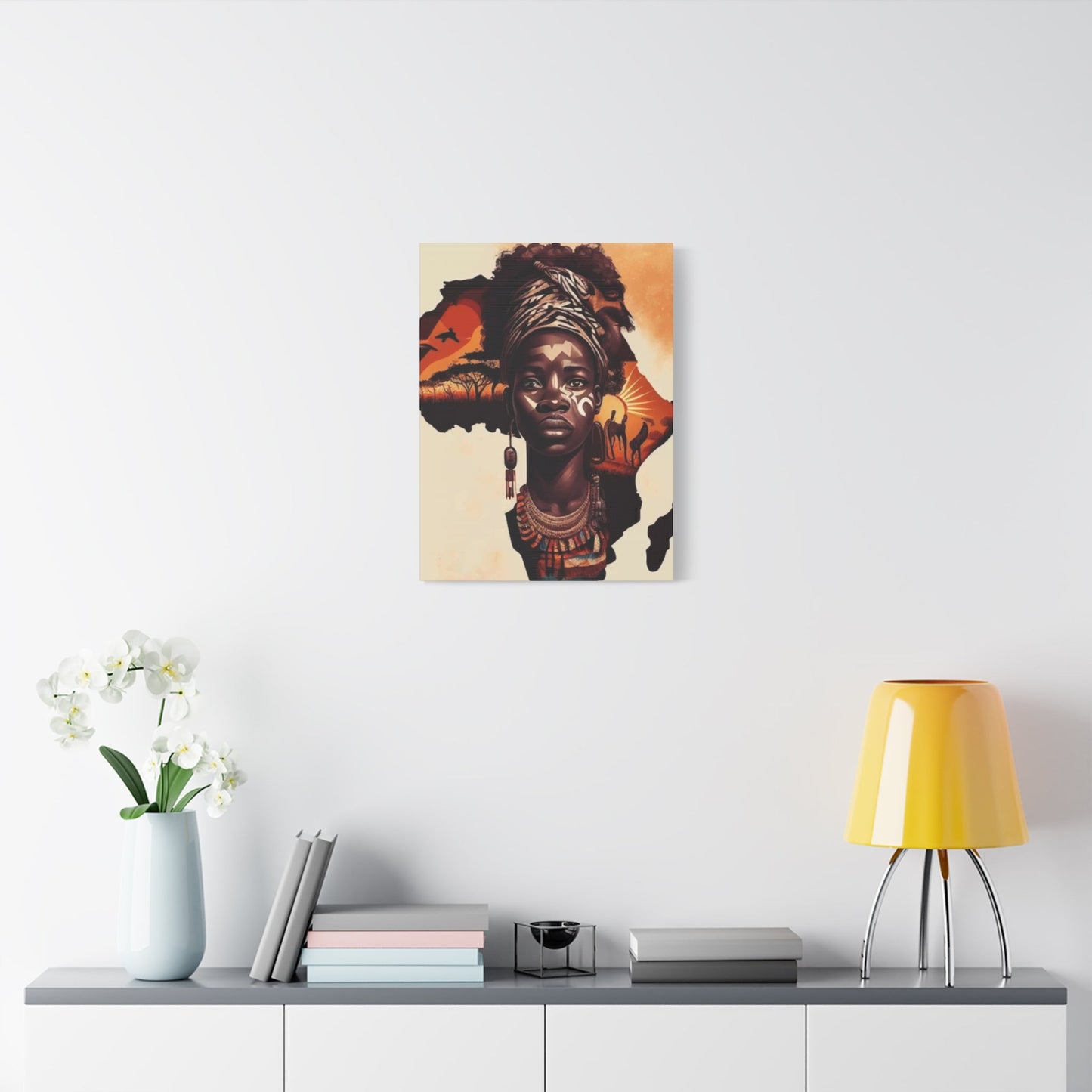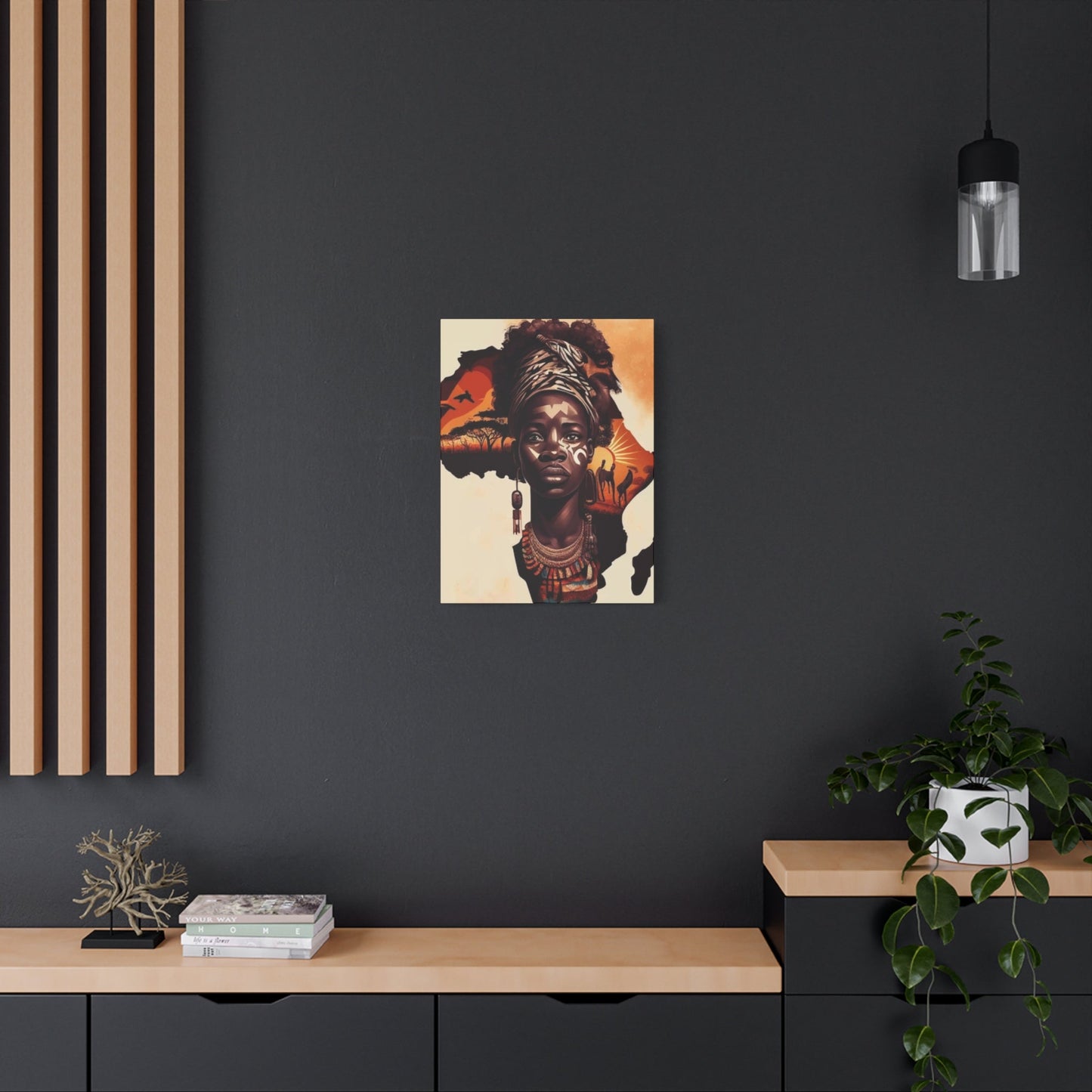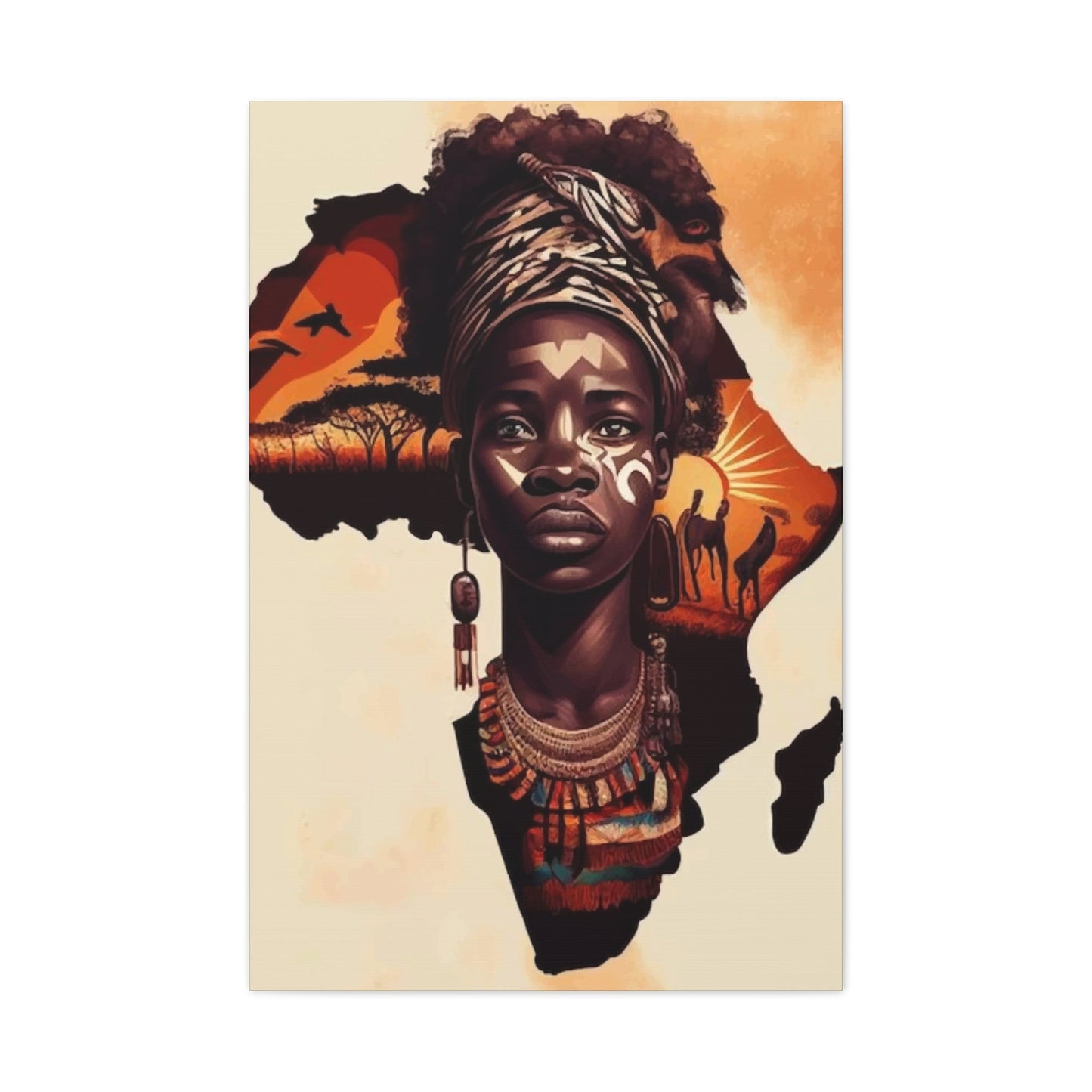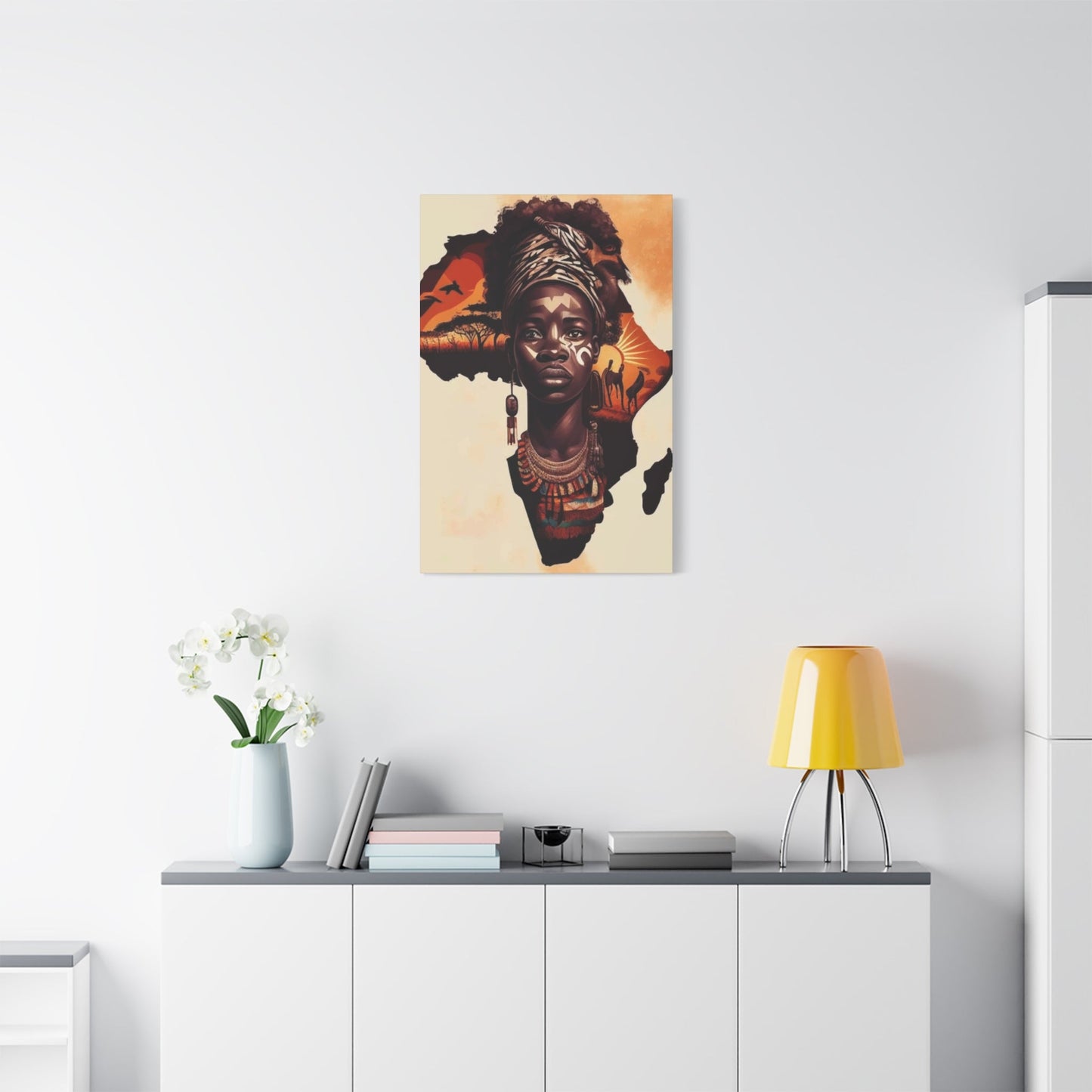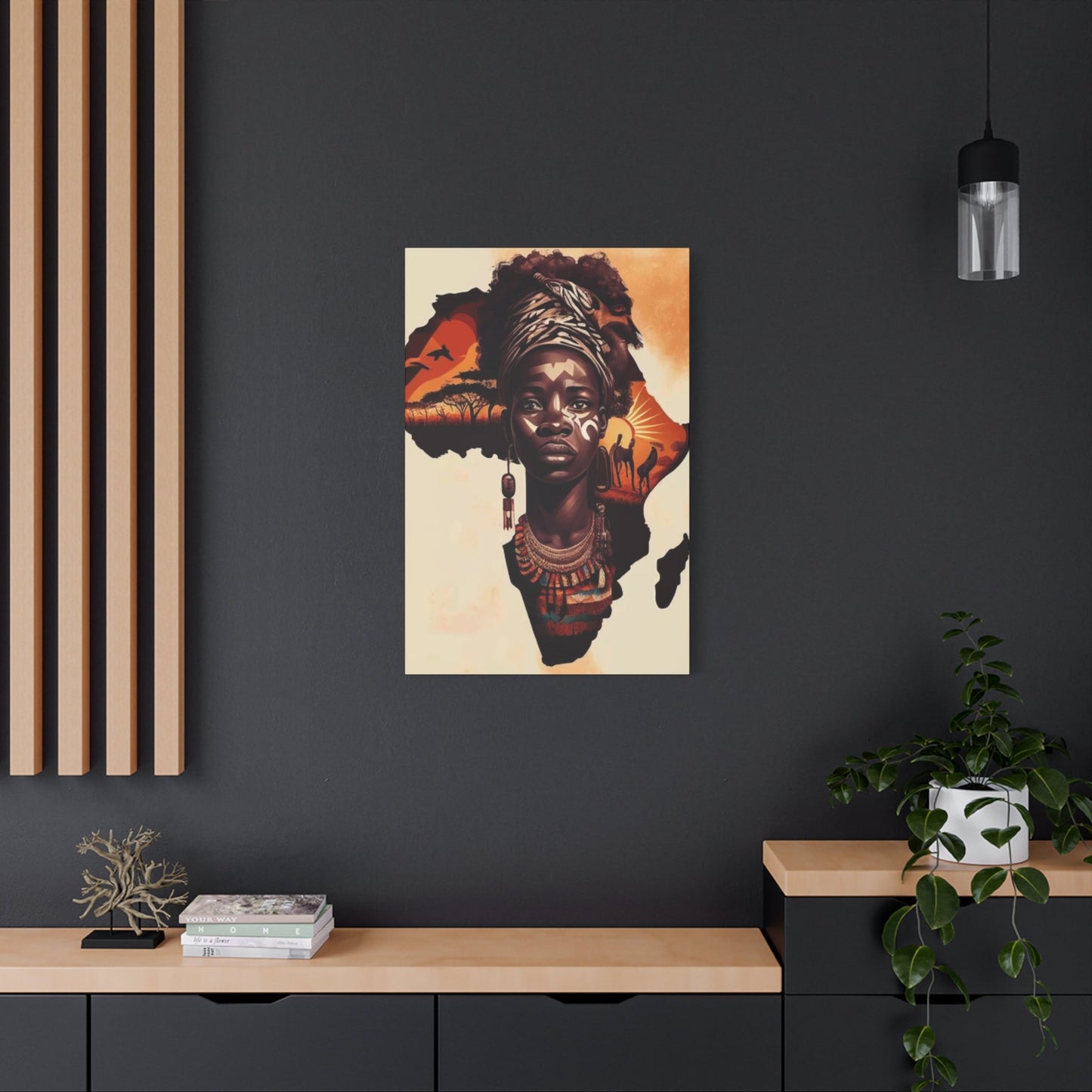African Map Wall Art Prints: Celebrate Heritage and Style
Transform your living space with the authentic beauty of traditional African tribal patterns incorporated into continental mapping designs. These remarkable pieces showcase the rich cultural heritage of Africa through intricate geometric patterns, symbolic representations, and traditional motifs that have been passed down through generations. The combination of geographical accuracy with artistic tribal elements creates a powerful visual statement that honors both the continent's physical boundaries and its diverse cultural identity.
When selecting a tribal motif canvas, consider the various regional patterns that represent different African communities. Kente-inspired designs from West Africa feature bold stripes and vibrant colors that symbolize different aspects of life, history, and social status. Ndebele patterns from Southern Africa incorporate geometric shapes and bright colors that traditionally decorated homes and represented family heritage. Maasai beadwork patterns from East Africa bring circular designs and earth tones that reflect the connection between people and nature.
The artistic process behind these canvases involves careful research into authentic tribal patterns while ensuring respectful representation of cultural elements. Many artists collaborate with cultural experts to ensure accuracy and appropriate use of traditional motifs. The result is a wall art piece that serves as both decoration and cultural education, bringing awareness to the rich artistic traditions of African communities.
These tribal motif canvases work exceptionally well in spaces that celebrate diversity and cultural appreciation. They complement both modern and traditional interior designs, adding depth and meaning to any room. The natural earth tones commonly found in tribal patterns make them versatile enough to coordinate with various color schemes while maintaining their distinctive character.
Installation considerations include proper lighting to highlight the intricate details of tribal patterns and choosing an appropriate size that allows viewers to appreciate the complexity of the motifs. Many collectors prefer to group these pieces with other cultural artifacts or travel memorabilia to create a cohesive theme that celebrates global diversity and artistic expression.
Sunset Safari African Map Wall Art
Experience the breathtaking beauty of African sunsets combined with the continent's distinctive silhouette through these spectacular wall art pieces. Safari sunset imagery captures the golden hour magic that defines the African landscape, where vast savannahs stretch endlessly under painted skies filled with warm oranges, deep purples, and brilliant reds. These artistic representations transform geographical maps into emotional experiences that evoke the wonder and majesty of African wilderness.
The visual impact of sunset safari maps extends beyond mere decoration to create atmospheric mood lighting effects within interior spaces. The warm color palette naturally complements various design schemes while adding a sense of adventure and wanderlust to any room. Professional artists often layer multiple techniques to achieve the depth and richness characteristic of African sunsets, including gradient blending, color washing, and strategic highlighting to create realistic sky effects.
Wildlife silhouettes frequently appear in these designs, featuring iconic African animals against the dramatic sunset backdrop. Elephants walking single file across the horizon, acacia trees dotting the landscape, and giraffes stretching their necks toward the painted sky all contribute to the authentic safari atmosphere. These elements are carefully positioned to maintain geographical accuracy while enhancing the artistic appeal of the continental outline.
The printing quality of sunset safari maps requires special attention to color reproduction and fade resistance. High-quality canvas materials and UV-resistant inks ensure that the vibrant sunset colors maintain their intensity over time, preventing the gradual fading that can occur with lower-quality reproductions. Professional framing options include both traditional frames and modern floating mount systems that allow the artwork to appear suspended within the frame.
Room placement strategies for sunset safari maps should consider natural lighting conditions throughout the day. These pieces often look most spectacular when positioned where they can catch natural light during golden hour periods, creating a beautiful interaction between the real sunset filtering through windows and the artistic sunset portrayed on the canvas. The warm color palette makes them particularly suitable for bedrooms, living rooms, and spaces designed for relaxation and contemplation.
Artistic African Map Featuring Iconic Wildlife
Celebrate the incredible biodiversity of Africa through stunning map designs that incorporate the continent's most recognizable and beloved wildlife species. These artistic interpretations go beyond simple geographical representation to showcase the natural habitat ranges, migration patterns, and ecological significance of African fauna within their continental context. Each piece serves as both a decorative element and an educational resource that highlights the importance of conservation and wildlife protection.
The artistic approach to wildlife integration varies significantly among different designs and artists. Some pieces feature realistic wildlife portraits positioned within their natural habitat ranges on the continental map, while others incorporate stylized animal silhouettes, abstract representations, or symbolic interpretations of various species. The choice of artistic style often depends on the intended use, room decor, and personal preferences of the collector.
Popular wildlife subjects include the Big Five safari animals: elephants, lions, leopards, rhinoceros, and buffalo, each representing different regions and ecosystems across Africa. However, comprehensive wildlife maps may also feature lesser-known but equally important species such as African wild dogs, cheetahs, giraffes, zebras, hippos, crocodiles, and various bird species that contribute to the continent's ecological diversity.
Conservation messaging often accompanies these wildlife-focused maps, subtly incorporating awareness about endangered species, habitat preservation, and the importance of sustainable tourism. Some designs include small text elements or symbols that provide information about conservation status, population numbers, or specific threats facing different species. This educational component adds depth and purpose to the decorative function of the artwork.
Color schemes for wildlife maps typically draw from the natural palette of African landscapes, including savannah golds, forest greens, desert oranges, and sky blues. These earth-tone color combinations create a cohesive visual experience that reflects the natural environment while remaining versatile enough to complement various interior design styles. The use of contrasting colors helps distinguish different geographical regions and highlight specific wildlife habitats.
Size considerations for wildlife maps depend on the level of detail and the number of species featured. Larger formats allow for more detailed wildlife illustrations and clearer geographical features, while smaller pieces work well as part of gallery wall arrangements or in spaces with limited wall area. Multi-panel designs offer flexibility in arrangement and can create dramatic focal points in larger rooms or hallways.
Minimalist Continent Map with Bold Borders
Embrace the power of simplicity with clean, minimalist African continent designs that focus on bold border definitions and essential geographical elements. These sophisticated pieces strip away unnecessary details to highlight the fundamental beauty of Africa's distinctive shape and proportions. The minimalist approach creates timeless artwork that transcends temporary design trends while maintaining strong visual impact through strategic use of negative space and bold line work.
The artistic philosophy behind minimalist mapping emphasizes the concept that less is more, allowing viewers to appreciate the inherent beauty of continental geography without distracting elements. Bold border treatments serve multiple purposes: they define the continent's boundaries with precision, create visual weight that commands attention, and provide opportunities for color contrast that enhances the overall composition. The thickness, color, and style of these borders significantly impact the piece's visual personality.
Color palette choices for minimalist maps often feature monochromatic schemes, high-contrast combinations, or carefully selected accent colors that maintain the clean aesthetic while adding visual interest. Black and white combinations create classic, timeless appeal that works well in modern and contemporary interiors. Single accent colors, such as deep blues, warm oranges, or forest greens, can add personality while maintaining the minimalist principles.
Typography integration in minimalist designs requires careful consideration of font selection, sizing, and placement. When country names or geographical features are included, they must complement the clean aesthetic rather than compete with the primary design elements. Sans-serif fonts typically work best with minimalist styles, and text placement should follow grid systems or natural geographical alignments to maintain visual harmony.
The versatility of minimalist African maps makes them suitable for various interior design styles, from Scandinavian and modern minimalist to industrial and contemporary schemes. Their clean lines and uncluttered appearance allow them to serve as either subtle background elements or bold statement pieces, depending on size, color choices, and placement within the room. This flexibility makes them popular choices for both residential and commercial spaces.
Framing options for minimalist maps should maintain the clean aesthetic while providing appropriate visual weight. Simple black or white frames, natural wood frames, or frameless mounting systems all work well depending on the specific design and room context. The goal is to enhance the artwork without adding visual complexity that contradicts the minimalist principles.
African Map Canvas with Vibrant Festival Colors
Immerse your space in the joyful energy of African celebrations through map designs that incorporate the brilliant colors and festive spirit of traditional African festivals. These dynamic pieces capture the essence of cultural celebrations, religious ceremonies, and community gatherings that define the social fabric of African societies. The vibrant color palettes reflect the diversity of festivals across the continent, from harvest celebrations to religious observances to community milestone events.
Festival color schemes draw inspiration from various cultural celebrations throughout Africa. West African festivals often feature bold yellows, oranges, and reds that symbolize prosperity, energy, and community strength. East African celebrations may incorporate blues and whites that represent sky and water, essential elements for agricultural communities. Southern African festivals often emphasize earth tones mixed with bright accent colors that reflect the connection between people and land.
The artistic process of creating festival-inspired maps involves layering multiple colors and techniques to achieve the depth and vibrancy characteristic of celebration atmospheres. Techniques such as color bleeding, gradient transitions, and strategic color placement create movement and energy within the static geographical outline. Some artists incorporate traditional fabric patterns, beadwork designs, or ceremonial symbols that reference specific festivals or cultural practices.
Cultural authenticity remains important when creating festival-inspired artwork, requiring research into the meanings and significance of different colors within various African cultures. Colors that represent joy and celebration in one culture may have different meanings in another, making cultural sensitivity and accuracy essential components of the artistic process. Many contemporary artists collaborate with cultural consultants or community members to ensure respectful representation.
The psychological impact of vibrant festival colors extends beyond aesthetic appeal to influence mood and atmosphere within interior spaces. These bright, energetic colors can create feelings of happiness, optimism, and cultural connection. They work particularly well in social spaces such as living rooms, dining areas, or entertainment rooms where the festive energy enhances social interactions and creates welcoming environments.
Lighting considerations for festival color maps include both natural and artificial lighting sources. These vibrant pieces often benefit from strategic lighting that enhances color saturation and creates dynamic shadows. LED lighting systems with color temperature control can be adjusted to complement the warm or cool tones within the festival palette, creating different atmospheric effects throughout the day.
Watercolor African Map Highlighting Major Cities
Discover the artistic beauty of watercolor painting combined with geographical precision in maps that showcase Africa's major urban centers through fluid, organic brushwork and translucent color layers. Watercolor technique brings a soft, artistic quality to continental mapping while allowing for creative interpretation of geographical features and urban areas. These pieces balance artistic expression with informational content, creating visually appealing artwork that also serves as educational resources about African cities and their relative locations.
The watercolor medium offers unique advantages for map creation, including the ability to blend colors naturally, create gradient effects that suggest topographical features, and achieve organic textures that contrast beautifully with the geometric precision of geographical boundaries. The transparency of watercolor allows for layering techniques that can represent different types of information, such as population density, elevation changes, or cultural regions, through varying color intensities and combinations.
Major city representation in watercolor maps varies from subtle color dots or washes to more detailed urban symbols or architectural silhouettes. Popular cities featured in these designs include Cairo, Lagos, Johannesburg, Nairobi, Casablanca, Addis Ababa, Dakar, and Cape Town, each represented in ways that reflect their significance and character. Some artists incorporate recognizable landmarks or architectural elements that help viewers identify specific cities while maintaining the fluid aesthetic of watercolor painting.
Color selection for watercolor maps often draws from natural palettes that complement the medium's organic qualities. Earth tones, ocean blues, desert oranges, and forest greens create authentic geographical references while allowing for artistic interpretation. The bleeding and blending characteristics of watercolor paints create natural variations and transitions that add visual interest and artistic depth to the geographical representation.
Technical considerations for watercolor map creation include paper selection, paint quality, and preservation methods. High-quality watercolor paper provides the right texture and absorbency for optimal paint behavior, while professional-grade paints ensure color stability and longevity. Proper sealing and framing protect the delicate watercolor surface from moisture damage and UV exposure that can cause fading or deterioration over time.
Size and scale decisions for watercolor maps depend on the level of detail desired and the intended viewing distance. Larger formats allow for more detailed city representations and clearer geographical features, while smaller pieces work well in intimate spaces or as part of gallery wall arrangements. The organic nature of watercolor makes it particularly suitable for irregular or non-standard canvas shapes that can add visual interest to room arrangements.
Rustic Wooden African Map Wall Art
Bring natural warmth and organic texture to your space with handcrafted wooden map designs that celebrate both African geography and traditional woodworking craftsmanship. These unique pieces combine the timeless appeal of natural wood with geographical accuracy, creating dimensional wall art that engages multiple senses and adds tactile interest to interior spaces. The rustic aesthetic celebrates the connection between African landscapes and natural materials, reflecting the continent's abundant forests and traditional woodworking traditions.
Wood species selection significantly impacts the final appearance and character of rustic map designs. African hardwoods such as mahogany, teak, ebony, and zebrawood offer rich colors and distinctive grain patterns that reflect the continent's natural resources. However, sustainable sourcing and environmental responsibility often lead artists to choose locally available woods or reclaimed materials that reduce environmental impact while maintaining aesthetic quality.
Craftsmanship techniques for wooden maps range from simple laser cutting and engraving to complex hand-carving and multi-layer construction. Laser-cut designs offer precision and consistency while allowing for intricate detail work and clean edges. Hand-carved pieces showcase individual artisan skills and create unique variations that make each piece one-of-a-kind. Multi-layer construction techniques can create dimensional depth that represents topographical features or adds visual interest through shadow effects.
Finishing options for wooden maps include natural oils, stains, and protective coatings that enhance grain patterns while providing durability and longevity. Natural finishes maintain the wood's organic appearance and allow the grain patterns to show through clearly. Staining techniques can create color variations that represent different geographical features, such as darker tones for forests and lighter tones for desert regions.
Installation considerations for wooden maps include weight distribution, wall mounting systems, and environmental factors. Solid wood pieces can be significantly heavier than canvas alternatives, requiring appropriate wall anchors and mounting hardware. Changes in humidity and temperature can affect wood dimensions, making proper spacing and mounting techniques important for long-term stability and appearance.
Maintenance requirements for wooden map art include regular dusting, occasional conditioning with appropriate wood care products, and protection from direct sunlight and moisture exposure. Proper care ensures that the natural beauty of wood grain patterns continues to develop and mature over time, often improving with age as the wood develops patina and character.
The versatility of rustic wooden maps makes them suitable for various interior design styles, from farmhouse and rustic to industrial and contemporary. Their natural materials complement both traditional and modern furnishings, adding warmth and organic texture that balances harder materials such as metal and glass commonly found in contemporary interiors.
African Map Canvas with Inspirational Travel Quotes
Combine geographical beauty with motivational messaging through map designs that incorporate carefully selected travel quotes, inspirational sayings, and wanderlust-inducing text elements. These pieces serve dual purposes as both decorative artwork and daily sources of inspiration, encouraging viewers to dream, plan, and pursue their travel aspirations while celebrating the beauty and diversity of the African continent.
Quote selection for travel-inspired maps requires careful consideration of relevance, cultural sensitivity, and inspirational value. Popular categories include quotes about adventure, discovery, cultural understanding, and personal growth through travel experiences. Sources range from famous explorers and travel writers to contemporary adventurers and cultural philosophers who have written about their African experiences or travel in general.
Typography design plays a crucial role in integrating text elements with geographical features without overwhelming the map's primary function. Font selection, sizing, and placement must balance readability with aesthetic appeal while maintaining appropriate hierarchy between geographical information and inspirational text. Hand-lettered elements can add personal touch and artistic flair, while clean sans-serif fonts offer modern appeal and excellent readability.
Layout strategies for quote integration include various approaches such as incorporating text within geographical boundaries, placing quotes in decorative frames or banners, or using text as background elements that don't compete with map details. Some designs feature quotes prominently as primary design elements, while others use text more subtly as accent elements that complement the geographical focus.
Color coordination between text elements and map features requires careful attention to contrast, readability, and overall aesthetic harmony. Text colors should provide sufficient contrast for easy reading while complementing the overall color scheme of the map design. Techniques such as drop shadows, outlines, or background panels can improve text legibility when placed over complex geographical features.
The psychological impact of inspirational quotes combined with travel imagery extends beyond decoration to influence mood, motivation, and goal-setting behaviors. These pieces can serve as daily reminders of travel aspirations, sources of motivation during challenging times, or conversation starters that encourage sharing of travel experiences and dreams among family members and visitors.
Customization options for quote-based maps allow for personalization that reflects individual travel philosophies, experiences, or aspirations. Custom quotes might include personal mantras, family mottos, or memorable sayings encountered during previous travels. This personalization creates deeper emotional connections between viewers and the artwork while maintaining the inspirational and geographical functions.
Modern Line Art African Map for Living Rooms
Embrace contemporary minimalism through sophisticated line art interpretations of African geography that emphasize clean lines, geometric precision, and modern aesthetic principles. These designs strip away unnecessary details to focus on essential geographical elements while incorporating contemporary artistic techniques that create visually striking focal points perfect for modern living spaces.
Line weight variations in modern map designs create visual hierarchy and depth while maintaining the clean aesthetic characteristic of contemporary art styles. Thicker lines might outline continental boundaries and major geographical features, while thinner lines define country borders, rivers, or other secondary elements. This strategic use of line weight guides viewer attention and creates visual interest without adding color or textural complexity.
Geometric interpretation of geographical features allows artists to simplify complex coastlines, mountain ranges, and river systems into clean, angular representations that maintain geographical accuracy while conforming to modern design principles. This approach creates artwork that functions equally well as geographical reference and abstract artistic expression, appealing to both map enthusiasts and contemporary art collectors.
Color schemes for modern line art maps typically feature monochromatic palettes or limited color combinations that maintain the clean, sophisticated appearance demanded by contemporary interior design. Black lines on white backgrounds create classic contrast and timeless appeal, while single accent colors can add personality and coordinate with specific room color schemes without compromising the modern aesthetic.
Integration with contemporary interior design requires consideration of furniture styles, room proportions, and existing artwork. Modern line art maps work particularly well in spaces featuring clean lines, minimal ornamentation, and neutral color palettes. They can serve as statement pieces in rooms with simple furnishings or as complementary elements in spaces with more complex design schemes.
Scale considerations for living room installations depend on wall dimensions, furniture arrangements, and viewing distances. Large-scale line art maps can create dramatic focal points above sofas or entertainment centers, while smaller pieces work well in gallery wall arrangements or as accents in reading nooks and conversation areas. The linear nature of these designs makes them particularly suitable for horizontal arrangements that complement standard furniture proportions.
Framing options for modern line art should maintain the clean aesthetic while providing appropriate visual weight and protection. Simple black or white frames, natural wood frames, or frameless mounting systems all work well depending on the specific design and room context. The goal is to enhance the artwork's contemporary appeal while ensuring proper presentation and protection.
African Map Highlighting Natural Wonders
Celebrate the extraordinary natural beauty and geological diversity of Africa through map designs that showcase the continent's most spectacular landscapes, landmarks, and natural phenomena. These educational and visually stunning pieces serve as both artistic decoration and geographical education, highlighting the incredible variety of ecosystems, landforms, and natural attractions that make Africa a premier destination for nature lovers and adventure seekers.
Featured natural wonders typically include iconic locations such as Victoria Falls, Mount Kilimanjaro, the Sahara Desert, the Nile River, the Great Rift Valley, Table Mountain, and the Okavango Delta. Each location is represented through artistic techniques that capture their unique characteristics and geographical significance while maintaining accuracy in positioning and scale relative to other continental features.
Artistic representation techniques vary depending on the specific natural wonder and the overall design aesthetic. Mountain ranges might be represented through elevation shading, topographical lines, or simplified silhouettes that suggest their height and prominence. Water features such as lakes, rivers, and waterfalls often incorporate blue tones and flowing lines that suggest movement and natural processes. Desert regions may feature warm color palettes and texture techniques that evoke sand dunes and arid landscapes.
Educational components of natural wonder maps often include brief descriptions, statistical information, or symbolic representations that provide context and background information about featured locations. This educational aspect transforms the artwork from pure decoration to learning resource, making these pieces particularly valuable for educational settings, travel planning, or cultural awareness initiatives.
Color palette selection for natural wonder maps draws from the actual colors and environmental characteristics of featured locations. Desert regions are represented through warm oranges, yellows, and browns, while forest areas feature various shades of green. Mountain regions often incorporate grays and whites to suggest rocky terrain and snow-capped peaks. Water features utilize various blue tones to represent different types of water bodies and their characteristics.
Conservation messaging may be subtly incorporated into natural wonder maps, raising awareness about environmental challenges, climate change impacts, or conservation efforts affecting these precious locations. This educational component adds depth and purpose to the decorative function while encouraging environmental consciousness and responsible tourism practices.
Size and detail considerations affect the ability to accurately represent multiple natural wonders while maintaining visual clarity and geographical accuracy. Larger formats allow for more detailed representations and additional natural features, while smaller pieces may focus on fewer locations with greater artistic interpretation. The balance between artistic appeal and educational value influences design decisions and target audience considerations.
Contemporary African Map with Metallic Touches
Add sophisticated glamour and modern elegance to your space with African map designs that incorporate metallic elements, reflective surfaces, and contemporary finishing techniques. These luxurious pieces combine geographical accuracy with high-end aesthetic appeal, creating statement artwork that elevates interior spaces while celebrating the beauty of African geography. Metallic treatments add depth, dimension, and visual interest that changes with lighting conditions and viewing angles.
Metallic application techniques range from subtle accent elements to bold, prominent features that dominate the overall design. Gold leaf applications create warm, luxurious highlights that can emphasize specific geographical features such as major cities, rivers, or cultural regions. Silver treatments offer cooler, more contemporary appeal that works well with modern color schemes and minimalist design approaches. Copper and bronze tones provide warm, organic metallic options that complement earth-tone color palettes.
Layering strategies for metallic elements require careful consideration of design hierarchy and visual balance. Metallic treatments might highlight continental boundaries, emphasize specific countries or regions, or create decorative borders and frames within the overall composition. The goal is to enhance rather than overwhelm the geographical content while adding luxury and sophistication to the artistic presentation.
Surface preparation and application methods significantly impact the final appearance and longevity of metallic treatments. Professional techniques ensure proper adhesion, even coverage, and resistance to tarnishing or wear over time. Different metallic materials require specific preparation and application procedures to achieve optimal results and maintain appearance quality.
Lighting considerations for metallic map displays become particularly important as reflective surfaces interact dramatically with both natural and artificial light sources. Strategic lighting can enhance metallic elements and create dynamic visual effects throughout the day, while poor lighting placement can create glare or diminish the metallic impact. LED lighting systems offer precise control over color temperature and intensity that can optimize metallic display effects.
Contemporary interior design integration requires balancing metallic elements with existing room features and color schemes. Metallic maps work particularly well in spaces featuring modern furnishings, clean lines, and sophisticated color palettes. They can serve as glamorous focal points in formal living areas or add luxury touches to professional spaces such as offices or conference rooms.
Maintenance requirements for metallic map art include gentle cleaning techniques that preserve metallic surfaces while removing dust and environmental deposits. Specific cleaning methods depend on the type of metallic treatment used and the underlying canvas or substrate materials. Proper maintenance ensures that metallic elements continue to provide their intended visual impact over time.
African Map Wall Art with Cultural Symbols
Explore the rich symbolic heritage of African cultures through map designs that incorporate traditional symbols, cultural icons, and meaningful representations from various African communities. These pieces serve as both geographical references and cultural education tools, celebrating the diversity of African societies while honoring the symbolic systems that have communicated meaning and identity across generations.
Symbol selection requires extensive research into authentic cultural representations and their appropriate usage contexts. Traditional symbols might include Adinkra symbols from Ghana, which represent concepts such as wisdom, strength, and unity. Egyptian hieroglyphics offer historical connections and ancient symbolic meanings. Ndebele geometric patterns provide colorful cultural references from Southern Africa. Each symbol system carries specific meanings and cultural significance that must be respected and accurately represented.
Geographical integration of cultural symbols requires careful consideration of cultural regions and historical accuracy. Symbols should be placed within their appropriate geographical contexts to maintain cultural authenticity and educational value. This geographical accuracy helps viewers understand the diversity of African cultures and their regional distributions while avoiding cultural misrepresentation or inappropriate symbol usage.
Artistic styling of cultural symbols can range from highly detailed, traditional representations to simplified, contemporary interpretations that maintain symbolic meaning while fitting within modern design aesthetics. The choice of styling depends on the intended use, target audience, and overall design philosophy of the piece. Traditional representations emphasize cultural authenticity, while contemporary interpretations may broaden appeal and integration with modern interior design.
Color significance plays important roles in many African cultural symbols, with specific colors carrying traditional meanings and cultural associations. Red might represent strength or life force, while blue could symbolize peace or healing. Understanding and incorporating these color meanings adds depth and authenticity to cultural symbol representations while creating more meaningful artistic experiences.
Educational components often accompany cultural symbol maps, providing explanations of symbol meanings, historical contexts, and cultural significance. This educational aspect transforms decorative artwork into learning opportunities that promote cultural understanding and appreciation. Brief explanations or symbol legends can be integrated into the design or provided as accompanying materials.
Cultural sensitivity and respectful representation remain paramount when incorporating traditional symbols into contemporary artwork. Many artists collaborate with cultural experts, community leaders, or cultural organizations to ensure appropriate usage and accurate representation. This collaborative approach helps avoid cultural appropriation while creating meaningful artistic expressions that honor African cultural heritage.
Geometric African Map in Abstract Style
Experience the beauty of African geography through contemporary abstract interpretation that emphasizes geometric shapes, pattern relationships, and mathematical precision. These innovative designs deconstruct traditional geographical representation to create artistic expressions that maintain continental recognition while exploring abstract artistic possibilities. The geometric approach appeals to both geography enthusiasts and abstract art collectors.
Geometric interpretation techniques transform organic geographical features into angular, mathematical representations that create visual rhythm and pattern recognition. Coastlines become series of connected straight lines, mountain ranges transform into triangular peaks, and river systems evolve into flowing geometric patterns. This mathematical approach creates artwork that functions as both geographical reference and abstract artistic expression.
Shape relationships within geometric maps create visual harmony through repetition, proportion, and systematic arrangement of geometric elements. Triangles might represent mountainous regions, circles could indicate major cities or lakes, and rectangles may define country boundaries or geographical regions. The consistent use of geometric shapes creates visual unity while maintaining geographical accuracy and recognition.
Color theory application in geometric maps often emphasizes contrast, harmony, and systematic color relationships that enhance the mathematical precision of the geometric approach. Complementary color schemes create visual excitement and energy, while analogous colors provide harmony and flow. Monochromatic schemes emphasize shape relationships and geometric patterns without color distraction.
Pattern integration allows geometric maps to incorporate repetitive elements that create visual texture and interest while maintaining geographical accuracy. These patterns might reference traditional African textile designs, architectural elements, or natural patterns found in African landscapes. The systematic repetition of geometric elements creates rhythm and movement that guides viewer attention across the continental outline.
Contemporary art integration makes geometric African maps suitable for modern and contemporary interior design schemes that emphasize clean lines, mathematical precision, and abstract artistic expression. These pieces work particularly well in spaces featuring minimalist furnishings, architectural details, and sophisticated color schemes that appreciate geometric complexity and abstract beauty.
Scale considerations affect the visibility and impact of geometric details within abstract map designs. Larger formats allow for more complex geometric patterns and detailed shape relationships, while smaller pieces may focus on simplified geometric interpretations that maintain visual impact at reduced scales. The balance between geometric complexity and visual clarity influences size and format decisions.
Personalized African Map Canvas for Travelers
Create meaningful connections between personal travel experiences and African geography through customized map designs that incorporate individual travel routes, destinations visited, and personal memories collected throughout the continent. These personalized pieces serve as both decorative artwork and travel journals, documenting adventures while inspiring future exploration and cultural discovery.
Customization options for traveler maps include various personal elements such as highlighted countries or cities visited, travel routes marked with lines or symbols, special dates and occasions marked on the map, personal photographs integrated into the design, or custom text elements including names, dates, or meaningful quotes. These personalization options create unique artwork that reflects individual travel experiences and personal connections to African destinations.
Travel route visualization techniques help document the progression of journeys across the continent while maintaining geographical accuracy and visual appeal. Routes might be represented through colored lines, dotted paths, or symbolic markers that indicate different types of transportation or travel experiences. Multiple trips can be distinguished through different colors, line styles, or symbol systems that create comprehensive travel documentation.
Memory integration allows travelers to incorporate specific experiences, photographs, or souvenirs into the map design through various artistic techniques. Small photographs can be incorporated as decorative elements, ticket stubs or stamps can be reproduced as design elements, and memorable quotes or experiences can be integrated as text elements. This memory integration creates emotional connections between the artwork and personal travel experiences.
Future planning functionality enables personalized maps to serve as both historical documentation and future inspiration through the inclusion of dream destinations, planned routes, or aspirational travel goals. Different visual treatments can distinguish between completed travels and future aspirations, creating comprehensive travel planning and documentation tools that evolve with ongoing travel experiences.
Gift potential for personalized traveler maps makes them meaningful presents for travel enthusiasts, study abroad participants, or individuals with special connections to African destinations. Custom elements can be tailored to specific individuals, relationships, or shared travel experiences, creating unique and thoughtful gifts that celebrate personal connections to African geography and culture.
Technical considerations for personalized map creation include high-resolution image requirements for custom photographs, proper file formats for custom text elements, and clear communication channels between customers and artists to ensure accurate representation of personal travel information. Professional production processes ensure quality results that meet personalization expectations while maintaining artistic and geographical standards.
African Map Wall Art with Sunset Gradient
Transform your space with the warm, inviting beauty of African sunsets interpreted through gradient color transitions that capture the magical quality of golden hour lighting across the continent. These artistic pieces combine geographical accuracy with atmospheric beauty, creating wall art that evokes the emotional impact of witnessing spectacular African sunsets while providing geographical reference and cultural connection.
Gradient technique applications in sunset maps utilize smooth color transitions that mimic the natural progression of sunset colors across the sky. Professional digital techniques or traditional painting methods create seamless blends from deep purples and oranges near the horizon to lighter yellows and pinks in the upper regions. These color transitions add depth and atmospheric perspective that transforms static geographical outlines into dynamic, emotionally engaging artwork.
Color psychology considerations recognize that sunset colors naturally evoke feelings of warmth, comfort, peace, and nostalgia. The warm orange and yellow tones associated with sunsets create welcoming environments that encourage relaxation and contemplation. These psychological effects make sunset gradient maps particularly suitable for bedrooms, living rooms, and spaces designed for rest and social interaction.
Seasonal variation interpretation allows sunset gradient maps to reflect different times of year and geographical locations across Africa. Dry season sunsets might feature more intense oranges and reds, while rainy season sunsets could incorporate more purples and grays. Desert region sunsets may emphasize warm, intense colors, while coastal area sunsets might include cooler blues and greens that reflect water influences.
Time of day representation through gradient positioning and intensity creates artwork that captures specific moments in the sunset progression. Early sunset representations might feature subtle gradients with gentle color transitions, while dramatic sunset interpretations could emphasize intense color contrasts and bold gradient effects. This temporal element adds narrative quality to the geographical representation.
Interior design integration requires consideration of existing room colors, lighting conditions, and furniture arrangements. Sunset gradient maps work particularly well with warm color schemes, natural materials, and lighting designs that complement the warm tones within the artwork. Strategic placement near windows or light sources can create beautiful interactions between natural light and the artistic sunset representation.
Lighting enhancement opportunities include both natural and artificial lighting strategies that optimize the visual impact of sunset gradient artwork. LED lighting systems with warm color temperatures can extend the sunset atmosphere into evening hours, while natural lighting during actual sunset times can create spectacular interactions between real and artistic sunset displays.
Vintage African Map Posters for Classic Interiors
Step into the golden age of exploration and discovery with authentic vintage-style African map designs that recreate the aesthetic and charm of historical cartography. These nostalgic pieces celebrate the rich tradition of map-making while honoring the exploratory spirit that led to greater understanding of African geography. The vintage approach appeals to history enthusiasts, antique collectors, and interior design schemes that appreciate classic elegance and historical references.
Historical accuracy in vintage map designs requires extensive research into authentic cartographic styles, typography, and design conventions from specific historical periods. Different eras of map-making offer distinct aesthetic characteristics, from medieval illuminated manuscripts to colonial-era exploration maps to early twentieth-century commercial cartography. Each period presents unique design opportunities and historical perspectives that influence artistic choices.
Aging techniques used in vintage map creation include various methods for achieving authentic antique appearance without compromising geographical accuracy or print quality. Tea staining, coffee aging, digital distressing, and carefully applied wear patterns create the patina and character associated with historical documents. These techniques must be applied skillfully to enhance rather than obscure geographical information and artistic quality.
Typography selection for vintage maps draws from historical font styles and lettering approaches that reflect authentic period cartography. Hand-lettered elements, serif fonts, and decorative script styles common in historical map-making create authentic vintage appeal. The integration of period-appropriate text elements, including compass roses, scale indicators, and decorative cartouches, enhances the historical authenticity.
Color palette development for vintage maps typically emphasizes muted, earth-tone colors that suggest age and historical authenticity. Sepia tones, faded blues, warm browns, and cream backgrounds create the color relationships associated with aged paper and historical printing techniques. These color choices contribute to the nostalgic atmosphere while maintaining sufficient contrast for geographical clarity.
Decorative elements common in vintage cartography include compass roses, sailing ships, sea monsters, decorative borders, and ornamental cartouches that add visual interest and historical flavor. These elements must be integrated thoughtfully to enhance rather than overwhelm the geographical content while maintaining authentic historical styling and appropriate scale relationships.
Frame selection for vintage map posters should complement the historical aesthetic through appropriate materials, styles, and finishes. Traditional wood frames with warm finishes, ornate decorative frames that reference historical periods, or simple frames that don't compete with the vintage map design all offer suitable options depending on the specific vintage style and room context.
Conclusion
African map wall art and canvas prints are more than just decorative pieces—they are a celebration of heritage, culture, and history, bringing both beauty and meaning into any space. By incorporating these artworks into your home, office, or classroom, you create a connection to the continent’s rich diversity, from its majestic landscapes and iconic wildlife to its vibrant cultures and complex histories. Each map print tells a story, offering a visual representation of Africa’s geography while serving as a symbol of pride and identity for those with African roots or an admiration for the continent’s uniqueness.
The versatility of African map canvas prints makes them suitable for a wide range of interior styles. Large, detailed maps can act as striking focal points above living room sofas, dining areas, or office desks, drawing attention and inspiring conversation. Smaller prints, on the other hand, work beautifully in clusters or gallery walls, allowing you to showcase multiple interpretations of the continent, from political boundaries and historical maps to abstract or artistic representations. The choice of style—whether traditional, watercolor, minimalist, or abstract—enables you to personalize your space, ensuring that the artwork complements existing décor while making a bold visual statement.
Beyond aesthetics, African map wall art serves an educational and cultural purpose. These prints can spark curiosity, encourage learning about the continent’s countries, capitals, and landmarks, and act as conversation starters that bring people together. They remind viewers of Africa’s immense geographical and cultural richness, inspiring appreciation and respect for its history, traditions, and global significance. Canvas prints also provide durability and quality, ensuring that the vibrancy of colors, the precision of details, and the overall impact of the artwork endure for years.
Choosing African map wall art and canvas prints is ultimately about more than decoration—it is about creating meaningful spaces that reflect personal identity, cultural pride, and a love for learning. These prints allow you to transform blank walls into immersive storytelling mediums, combining art, education, and cultural heritage in one elegant display. Whether you are decorating a modern home, a professional office, or a learning environment, African map canvas prints offer a timeless, versatile, and visually captivating way to celebrate the continent’s legacy while enhancing your interior design. By displaying these works of art, you honor Africa’s landscapes, cultures, and stories, creating a space that is not only beautiful but also deeply significant.













